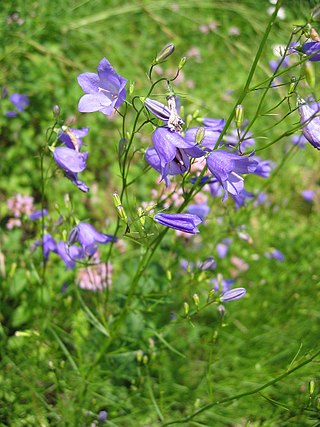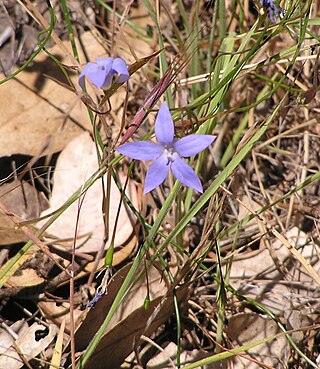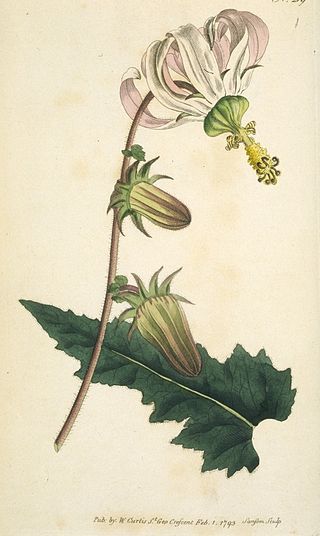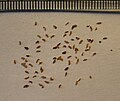
The family Campanulaceae, of the order Asterales, contains nearly 2400 species in 84 genera of herbaceous plants, shrubs, and rarely small trees, often with milky sap. Among them are several familiar garden plants belonging to the genera Campanula (bellflower), Lobelia, and Platycodon (balloonflower). Campanula rapunculus and Codonopsis lanceolata are eaten as vegetables. Lobelia inflata, L. siphilitica and L. tupa and others have been used as medicinal plants. Campanula rapunculoides may be a troublesome weed, particularly in gardens, while Legousia spp. may occur in arable fields.

Campanula rotundifolia, the harebell, Scottish bluebell, or bluebell of Scotland, is a species of flowering plant in the bellflower family Campanulaceae. This herbaceous perennial is found throughout the temperate regions of the northern hemisphere. In Scotland, it is often known simply as bluebell. It is the floral emblem of Sweden where it is known as small bluebell. It produces its violet-blue, bell-shaped flowers in late summer and autumn.

Wahlenbergia is a genus of around 260 species of flowering plants in the family Campanulaceae. Plants in this genus are perennial or annual herbs with simple leaves and blue to purple bell-shaped flowers, usually with five petals lobes. Species of Wahlenbergia are native to environments on all continents except North America, and on some isolated islands, but the greatest diversity occurs in the Southern Hemisphere.

Phyteuma is a genus of flowering plants in the family Campanulaceae, native to Europe and Morocco.

Nemacladus is a genus of flowering plants in the bellflower family known generally as threadplants. Species are native to the southwestern United States and northern Mexico. These are annual herbs with very slender, sometimes threadlike, branching stems bearing small five-lobed flowers.

Triodanis perfoliata, the clasping Venus' looking-glass or clasping bellflower, is an annual flowering plant belonging to the family Campanulaceae. It is an annual herb native to North and South America, the natural range extending from Canada to Argentina. It is also naturalized in China, Korea and Australia.

Palmerella is a genus of plants in the family Campanulaceae. It has only one known species, Palmerella debilis, long known by the synonym Lobelia dunnii. It is native to 8 counties in southern California plus the northern part of Baja California.
Solenopsis is a genus of plants in the Campanulaceae. It is native to the Mediterranean region from Portugal and the Canary Islands east to Turkey.
Pseudonemacladus is a genus of plants in the Campanulaceae. It contains only one known species, Pseudonemacladus oppositifolius, native to north-eastern Mexico.

Petromarula is a genus of plants in the family Campanulaceae. There is only one known species, Petromarula pinnata, endemic to the island of Crete in the Mediterranean. The name "Petromarula" means "rock lettuce" in Greek, a reference to the plant's traditional use in salads.

Ostrowskia is a genus of plants in the family Campanulaceae. There is only one known species, Ostrowskia magnifica, native to the Central Asian nations of Afghanistan, Kyrgyzstan and Tajikistan.

Musschia is a genus of plants in the family Campanulaceae. It contains three known species, all endemic to the Madeira Archipelago in the eastern North Atlantic, part of the Republic of Portugal. The genus is named in honour of Jean-Henri Mussche (1765-1834), the head gardener of the botanical garden in Ghent.
Sergia is a genus of plants in the family Campanulaceae. It contains two known species, both native to Central Asia.

Merciera is a genus of plants in the family Campanulaceae. It contains 6 known species, all endemic to Cape Province in South Africa.

Michauxia is a genus of plants in the family Campanulaceae. It contains 7 known species native to southwestern Asia.

Zeugandra is a genus of plants in the family Campanulaceae. It contains two known species, both endemic to Iran.
Treichelia is a genus of plants in the Campanulaceae. It contains two known species, both endemic to Cape Province of South Africa.

Theilera is a genus of plants in the Campanulaceae. It contains two known species, both endemic to Cape Province of South Africa.
Siphocodon is a genus of plants in the family Campanulaceae. It contains two known species, both endemic to Cape Province of South Africa.

Wahlenbergia capillaris, commonly known as tufted bluebell, is a plant in the family Campanulaceae and is native to Australia and New Guinea. It is an erect perennial herb with a few to many stems and grows to a height of 50 cm (20 in). The leaves are mostly linear with a few scattered teeth on the sides and the flowers are blue, bell-shaped with five lobes and arranged in cymes. This bluebell is widespread and common, occurring in all Australian mainland states and territories.



















